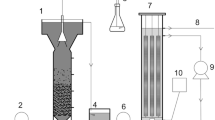Abstract
Micro-aeration, which refers to the addition of very small amounts of air, is a simple technology that can potentially be incorporated in septic tanks to improve the digestion performance. The purpose of this study was to investigate and compare the effects of micro-aeration on anaerobic digestion of primary sludge under septic tank conditions. 1.6 L batch reactor experiments were carried out in duplicate using raw primary sludge, with 4.1 % total solids, and diluted primary sludge, with 2.1 % total solids. Reactors were operated for 5 weeks at room temperature to simulate septic tank conditions. Micro-aeration rate of 0.00156 vvm effectively solubilised chemical oxygen demand (COD) and improved the subsequent degradation of COD. Micro-aeration also increased the generation of ammonia and soluble proteins, but did not improve the reduction in total and volatile solids, or the reduction in carbohydrates. Experiments using diluted sludge samples showed similar trends as the experiments with raw sludge, which suggest that initial solids concentration did not have a significant effect on the degradation of primary sludge under septic tank conditions.








Similar content being viewed by others
References
Luostarinen S, Sanders W, Kujawa-Roeleveld K, Zeeman G (2006) Effect of temperature on anaerobic treatment of black water in UASB-septic tank systems. J Bioresour Technol 98:980–986
Hammond C, Tyson T (1991) Septic tank design and construction. University of Georgia, Cooperative Extension Service. Report. Athens GA
Johansen J-E, Bakke R (2006) Enhancing hydrolysis with microaeration. Water Sci Technol 58(8):43–50
Park C, Abu-Orf MM, Novak JT (2006) The digestibility of waste activated sludges. Water Environ Res 78(1):59–68
Kumar N, Novak JT, Murthy S (2006) Effect of secondary aerobic digestion on properties of anaerobically digested biosolids. Proceedings of the water environment federation, WEFTEC 2006 conference: session 81 through session 94, pp 6806–6829
Novak JT, Banjade S, Murthy SN (2011) Combined anaerobic and aerobic digestion for increased solids reduction and nitrogen removal. Water Res 45:618–624
Pérez-Elvira SI, Nieto Diez P, Fdz-Polanco F (2006) Sludge minimisation technologies. Rev Environ Sci Biotechnol 5:375–398
Zhu M, Lü F, Hao L-P, He P-J, Shao L-M (2009) Regulating the hydrolysis of organic waste by micro-aeration and effluent recirculation. Waste Manag 29:2042–2050
Díaz I, Donoso-Bravo A, Fdz-Polanco M (2011) Effect of microaerobic conditions on the degradation kinetics of cellulose. Bioresour Technol 102:10139–10142
Jenicek P, Celis CA, Koubova J, Ruzickova I (2011) Change in the digested sludge quality at microaerobic digestion. J Residuals Sci Technol 8(2):39–44
Díaz I, Pérez SI, Fdz-Polanco M (2011) Effect of oxygen dosing point and mixing on the microaerobic removal of hydrogen sulfide in sludge digesters. Bioresour Technol 102:3768–3775
Jenicek P, Celis CA, Koubova J, Pokorna D (2011) Comparison of the microbial activity in anaerobic and aerobic digesters. Water Sci Technol 63(10):2244–2249
Jenicek P, Koubova J, Bindzar J, Zabranska J (2010) Advantages of anaerobic digestion of sludge in microaerobic conditions. Water Sci Technol 62(2):427–434
Bradford MM (1976) A rapid and sensitive method for the quantification of microgram quantities of protein utilizing the principle of protein–dye binding. Anal Biochem 72:248–254
Morris DL (1948) Quantitative determination of carbohydrates with Dreywood’s anthrone reagent. Science 107:254–255
American Public Health Association (APHA), American Water Works Association (AWWA) and Water Environment Federation (WEF) (2005) In: Standard methods for the examination of water and wastewater, 21 edn. APHA/AWWA/WEF, Washington DC
Pirt SJ, Lee YK (1983) Enhancement of methanogenesis by traces of oxygen in bacterial digestion of biomass. FEMS Microbiol Lett 18:61–63
Stein Carter JL (2004) Amino acids and proteins. U. Cincinnati, Clermont College, OH. http://biology.clc.uc.edu/courses/bio104/protein.htm. Accessed 5 2012
Author information
Authors and Affiliations
Corresponding author
Rights and permissions
About this article
Cite this article
Diak, J., Örmeci, B. & Kennedy, K.J. Effect of micro-aeration on anaerobic digestion of primary sludge under septic tank conditions. Bioprocess Biosyst Eng 36, 417–424 (2013). https://doi.org/10.1007/s00449-012-0798-x
Received:
Accepted:
Published:
Issue Date:
DOI: https://doi.org/10.1007/s00449-012-0798-x




